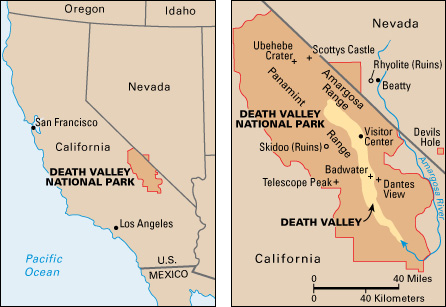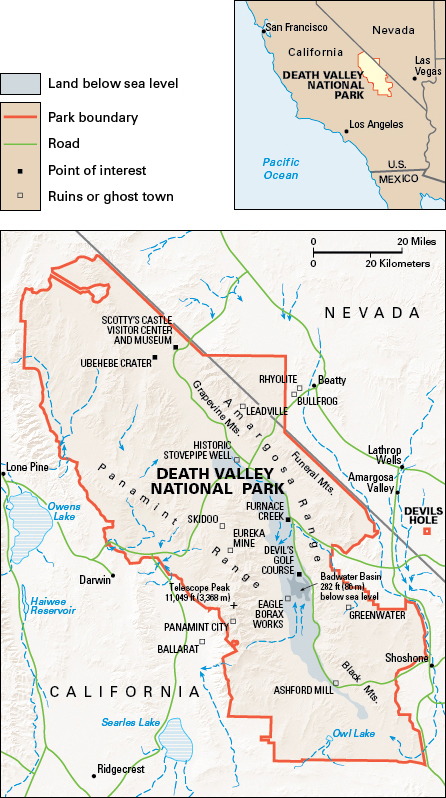Death Valley lies chiefly in east-central California. A small part of it extends into Nevada. A group of pioneers named the valley for its desolate desert environment after they crossed it in 1849. It is part of Death Valley National Park.
Death Valley is a deep trough, about 130 miles (209 kilometers) long and from 6 to 14 miles (10 to 23 kilometers) wide. The lowest elevation in the Western Hemisphere is near Badwater in Death Valley. It lies 282 feet (86 meters) below sea level. The Panamint Mountains stand west of the valley. Telescope Peak in the Panamint range is 11,049 feet (3,368 meters) high. The Amargosa Range, composed of the Grapevine, Funeral, and Black mountains, rises to the east.

The valley is a graben—a block in Earth’s surface, dropped down by faults that form its east and west walls. Faults occur when Earth’s rocky outer shell breaks and the rock along the break slips. Erosion of the steep cliffs has formed beautiful canyons. In the northern part of the valley is Ubehebe Crater, a small volcano on the west-side fault. Flows of lava issue from the faults in the southern part of Death Valley.
During glacial times, the climate was moister, and a large lake occupied Death Valley. Today, rainfall averages about 2 inches (5 centimeters) a year there. The highest temperature ever recorded in the world, 134 °F (57 °C), was reported in Death Valley on July 10, 1913. Summer temperatures of 125 °F (52 °C) are common. The valley’s geological attractions and warm winter sunshine have made it a popular winter-resort area. Plants include the creosote bush, desert holly, and mesquite. Wildlife includes bobcats, coyotes, foxes, reptiles, and squirrels.

Borax deposits were discovered in Death Valley in 1873. Actual mining began in the early 1880’s, and famous 20-mule teams hauled the borax out of the valley. Prospectors also discovered copper, gold, lead, and silver in nearby mountains. Mining towns sprang up, with such colorful names as Bullfrog, Greenwater, Rhyolite, and Skidoo. The towns died when the ores were exhausted. Today only cluttered debris remains.

